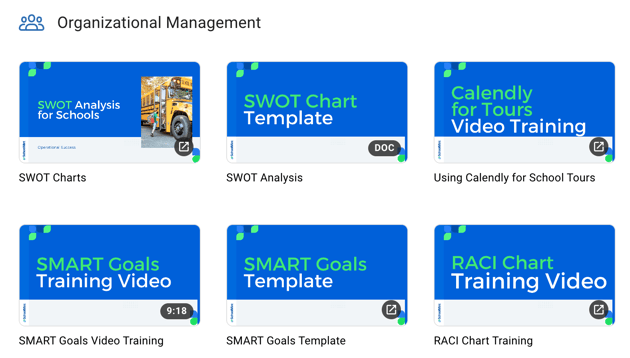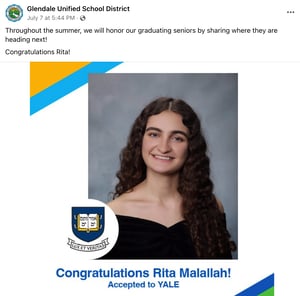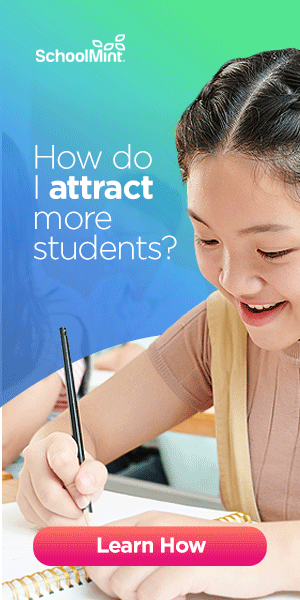20 Tips for School Social Media
With nearly four billion users across all platforms, social media is a great way to communicate with families, boost your student enrollment, and build your school’s online brand and reputation.
Perhaps your school has a phenomenal use of social media. Perhaps you use social media but it’s not your focus. Or maybe your school doesn’t bother with social media at all.
If you fall into the latter category and are wondering if social media is worth your time, yes! Your school needs social media:
- Families are there. The typical internet user spends two-and-a-half hours on social media each day.
- Social media creates an opportunity for families to engage with you.
- School social media is a highly effective student recruitment tool.
So let’s dive into how to market your school on social media with 20 tips and best practices!
Table of Contents
- Set Goals for Your School’s Social Media
- Audit Your School’s Social Media
- Ensure the Accuracy of Your School’s Information
- Choose Your Primary Social Media Platforms for Your School
- Designate a School Social Media Point Person
- Plan a School Social Media Calendar
- Post Variety, Post Consistently, Post Quality
- Gather User-Generated Content for Your School
- Promote Your School’s Social Media
- Engage with Followers to Expand Your Reach
- Use Data to Drive Social Media Decisions
- Automate Your Posting
- Run School Social Media Ads
- Identify Your Best Posting Times
- Reuse Content as Much as Possible
- Target the Right Audience
- Ask for Reviews
- Create Facebook Groups for Current Families and Graduates
- Incorporate Social Media Into Your Emergency and Crisis Communication Plan
- Host Social Media Training for Staff
1. Set Goals for Your School’s Social Media
Setting goals for your school’s social media matters because you’ll have something to aim for and be able to get buy-in from leadership when you make larger requests, such as getting an advertising budget for social media ads.
Think hard about what you want to accomplish with your school’s social media. Do you want to attract new students? Gain followers? Deepen engagement with families? Share school communications?
You probably want to do all of those things. Setting SMART goals — specific, measurable, achievable, relevant, and time-bound goals — for your school’s social media plan will help you:
- Manage your budget (if there is one).
- Justify your investment of time and resources into social media.
- Ensure your school’s social media strategy is aligned to wider enrollment goals.
To help you create your SMART goals, sign up for our free SchoolMint Enrollment Academy, where you can download a nifty SMART goals template (among many other things).
To learn how you can get free, unlimited access to materials in the academy, click the button below:
2. Audit Your School’s Social Media
Once you’ve decided what you want to accomplish with your school’s social media, determine where it stands currently. Start by reviewing some basic information about your platforms:
- Which platforms do you have a presence on? There are tools that can help you find “stray” social media accounts. Try one out, especially if you are new in your role at your school/district. You might find a surprise abandoned account from 10 years ago.
- When was the last time your accounts were active? Was it last week? Last year? And who’s responsible for posting? If you send the account a DM, does it get a response?
Do a quick audit your competition, too.
You probably have a good idea of who your “competition” is, so do a quick review of what schools in your area are doing on social media:
- What platforms are they using?
- How often do they post?
- What are they posting?
- Which of their posts get the most engagement?
This review doesn’t need to be ultra-detailed. With some basic information, you can identify the strengths and weaknesses of your competitors — and the opportunities for you to swoop in and have the best school social media around.
3. Ensure Accuracy of Your School’s Information
All platforms ask for the same general basic information: your school’s name, address, phone number, a brief description, logo, and so on.
If your presence across platforms varies wildly, people may question the professionalism of your organization.
Here are some things to check/update:
- Make sure all information about your school is accurate and identical across all platforms. Using different logos can confuse families on whether they’re looking at the right page.
- If you have a different phone number on your Facebook page versus on your school’s website, a parent may not know which number is best to call. School communication is already hard enough — don’t unintentionally give off the impression your school will be difficult to reach if they enroll with you!
- Click all links (such as your website’s URL), email all contact email addresses, and call all phone numbers to be sure everything works.
I know this all seems like very obvious, tedious work, but trust me — you’ll likely find at least one thing that’s wrong. It happens to me all the time in my own education marketing role!
4. Choose Your Primary Social Media Platforms for Your School
Your school social media options are plenty, spanning from the major players — Facebook, Instagram, Twitter — to the barely used (did you know Myspace still exists?).
I recommend establishing a presence on the two major social media platforms for schools — Facebook and Instagram — and getting a YouTube account.
Also, know that it’s best to do a few platforms well than to do many platforms poorly.
Why are Facebook and Instagram so important for schools?
It’s all about the massive population on each platform and the age breakdown of the people using it:
- 77% of adults 30–49 years old are on Facebook. That age group makes up a huge chunk of your target audience: millennials!
- Instagram’s user base is an impressive 77.7% of people ages 18 to 44 years old. That age range captures your entire target audience — millennials as well as young Gen Z parents.
You can create a school account on TikTok and other platforms if you wish, even if it’s just to claim your name so that no one can use your school’s likeness for parody or malicious purposes (not that any bored middle school kid would ever do that).
Also, not every platform will reach the right audience for every message. If you’re announcing an upcoming Open House event, Facebook and Instagram will reach your target audience better than TikTok.
Now, if your cheerleaders want to show off a new cheer? By all means, use TikTok!
Interested in receiving more content like this blog in the future?
Then sign up for our enrollment-focused newsletter, the SchoolMint Insider! Every two weeks, you’ll receive the latest in social media for schools, student recruitment, and more.
5. Designate a School Social Media Point Person
Choose a person who will run point with your school’s social media accounts. For school leaders who are already stretched thin, you’ll benefit from having someone manage social media.
This person will coordinate resources, enlist help from the school community, and be accountable for reaching social media goals. When you have a question or request, you’ll know who to go to.
Even though your school or district very likely can’t budget for a dedicated social media manager, you can still get others involved to maximize your marketing resources. For example, you can get students involved!
6. Plan a School Social Media Calendar
With a social media calendar, you’ll avoid scrambling each day, frantically wondering what you should post. You can plan out content in advance to align with school initiatives, holidays, events (e.g., the 100th Day of School, Teacher Appreciation Week, etc.), and deadlines.
Your calendar will also determine how frequently you post. If you can manage only two or three posts a week, that’s fine.
What should be on your school’s social media calendar?
- What and when you will post
- What the post will say (this is arguably the most tedious part of posting to social media, but we have a great training in SchoolMint Enrollment Academy on how you can use AI to create a month’s worth of social media posts for your school)
- What graphics you will need (e.g., “photos from the science museum field trip” or “pics from Muffins with Mom breakfast”)
You can make your own with a simple spreadsheet. Or you can sign up for our awesome SchoolMint Enrollment Academy, where we have a free social media calendar ready and waiting for you to download!
The academy hosts a bunch of school social media resources for you to use at your leisure — including, of course, a holiday calendar (see below) for those weeks when you just can’t think of what to post.
7. Post Variety, Post Consistently, Post Quality
Three things go into a great school social media timeline: variety, consistency, and quality. What that means is you want to consistently post a variety of high-quality content.
a. Variety
People use social media for many reasons. Some want to keep in touch with family. Others want news articles or funny videos. Some want cat memes and national parks (i.e., me).
Your current students and parents will want school updates. Prospective families will want to get an idea of who you are.
Keep a variety of content on your calendar to keep your timeline interesting and to hit on all the different ways people like to digest information. For example, create posts that use infographics, videos, photo sets, polls, and more.
Here are some ideas for your school’s social media calendar:
- Videos
- Infographics (dress code, drop-off and pick-up reminders, etc.)
- Faculty features (get teachers involved in your school’s marketing!)
- Themes (Motivational Monday, Teacher Tuesday, Way-Back Wednesday, Throwback Thursday, Fun Fact Friday, etc.)
- Events and important dates
- Seasonal content (both official and just-for-fun holidays)
- Updates from your school or your principal’s blog
b. Consistency
Consistency is important for school social media because anyone looking at your profile will see you’re active and engaged. It’s not a good look to go on a school’s profile and see it was last updated in 2019.
Additionally, social media algorithms prioritize pages that post frequently. Note, though, that this doesn’t mean spamming your audience. Restrict yourself to posting quality content at daily or twice-daily intervals.
And really, if in doubt, worry less about how much you’re posting and more about the quality of it. If you have multiple great things to share in one day, do it. There are no rules in social media — except the ones you agreed to when signing up; you did read that user agreement, right?
c. Quality
A high-quality social media post contains information your school audience wants to see. A good social post for your school is something like:
- The warm-and-fuzzy posts that get your families excited to see their children.
- The funny videos your students and teachers make.
- A hilarious selfie of your principal cheesing with the custodians or your cafeteria team’s latest creation.
- #ThrowbackThursday yearbook photos of your teachers as students.
Or it’s a post celebrating your high school graduates, such as this one from Glendale Unified School District:
Your followers want posts that are informative, funny, thought-provoking, or authentic.
These posts will connect them deeper to you, which increases the chance they’ll do what you want them to do: like, comment, share, and follow you for more. If they’re a new parent, this may even be the impetus they need to start the enrollment process with you.
8. Gather User-Generated Content for Your School
User-generated content (UGC) is content that someone outside your organization creates and lets you use. The key advantage of user-generated content is that it’s authentic.
Here’s an example of UGC in action, courtesy of the social media masters of National Geographic:

How can you implement user-generated content into your school’s social media strategy?
- Host a contest (art competition, costume contest, etc.) and ask families to submit their entries.
- During significant days, like the famous First Day of School, ask families to share their photos.
- When a parent or guardian tags you in something on social media, reshare it!
Just be sure to ask if it’s all right for you to repost content or make it known your school will be featuring any submitted photos.
9. Promote Your School’s Social Media
Any chance you get, promote your school’s social platforms. Here are some ways you can do that:
- Place social media icons and link out to your platforms on your school’s website. Make sure those pages are linked correctly.
- Call out your social media accounts in school materials, both printed pieces and digital content.
- When in contact with parents and guardians, remind them to follow you.
- Place links to your social media accounts in your school email footer.
- Link to your other platforms on each platform by using a platform-linking tool.
In the image below, notice the dark blue link in the Instagram bio of Memphis-Shelby County Schools.

They use a tool called Lnk.Bio, which makes it easy for you to link your social media accounts (plus other links, such as your website, enrollment page, etc.) in one place. LinkTree is another popular tool for this.
10. Engage with Followers to Expand Your Reach
Encouraging followers to like, comment, and share your posts is a mantra for increasing your school’s followers on social media. Posts with high engagement rank higher in people’s feeds than posts with little engagement.
This creates a ripple effect: When someone interacts with a post, that post will then appear on the timelines of people they know, which expands your reach to people who don’t even follow you.
For example: Sarah is a parent whose child is enrolled with you. Sarah follows your school on Facebook. You post a picture, and Sarah comments on the post. Nathan is friends with Sarah, but he doesn’t follow your school’s Facebook. But because he is friends with Sarah, the post appears on his timeline, too.
Additionally, if someone comments with a question, answer it! If they leave a comment, acknowledge it.
What about negative comments? Don’t focus on them. If it’s a serious matter, invite the person to get in touch off social media. If it’s someone just “trolling,” hide their comment. They’ll see their remark, but no one else will.
- Additional Reading: Dealing with Negative Reviews of Your School
11. Use Data to Drive Social Media Decisions
While you can get very technical with social media data, even high-level insights can drive big improvements with your school’s accounts. For example:
- Where do you have the most followers?
- Which of your posts get the most engagement?
- What times and days of the week do people engage with your posts?
Even if you can answer only those questions, you can learn which platform deserves the bulk of your energy, what you should post more of, and when you should post it.
12. Automate Posting with Evergreen Content
Any school doing social media should automate posting (there are many platforms that offer free versions for this) as much as possible, especially if you work in an enrollment or communications role. If you invest time creating “evergreen content,” automating your posting will be even easier.
Evergreen content is content with a long shelf life — meaning it’s something you can, in theory, post at any time of the year.
For example, a post about your upcoming Open House isn’t evergreen because there’s a specific date and time it’s happening.
However, posts like these would be evergreen:
- Instructional videos (e.g., how parents can enroll with you)
- Informational videos (e.g., a virtual tour of your facilities)
- School tips and guidelines (e.g., attendance policy reminders)
- Educational/fun articles (e.g., 10 Things Your Child Will Learn in Their First Year at [School])
13. Run School Social Media Ads
Advertising your school on social media will get your school in front of brand-new audiences — such as prospective parents who don’t know your school even exists.
To reach new families and increase your enrollment, add paid advertising to your school’s social media strategy for Facebook and Instagram.
Advertising your school on social media is 100% necessary to expand your school’s reach beyond your current audience.
For an example of a great school enrollment ad, check out this one from our SchoolMint Engage and digital ads client, Maria Saucedo Scholastic Academy (part of Chicago Public Schools):
Learn how we helped Maria Saucedo enroll 175 new students in the case study here.
The key benefit of school social media ads is that you can target people in a set geographic area.
When you run ads for your account, you can rest assured you won’t be wasting money advertising your school to families across the country.
Additionally, with social media ads, you can get your message across to people who haven’t followed your school on social media, changing their perception of your organization.
Need help with social media ads for your school?
While paid school ads are something you can do yourself, it has a steep learning curve, and it can take time to learn best practices for school social media advertising.
So if you have the budget to run some school ads, let SchoolMint help!
SchoolMint offers social media and search engine advertising services for charter schools and school districts. With our digital advertising solution for K-12, you’ll work with a consultant to advertise your school(s) on Facebook and Instagram.
14. Identify Your Best Posting Times
Identify the best times to post for your school’s social media so that you’re serving up content to your followers when they’re most likely to be checking the platform. When is the best time and day to post?
The social media marketing experts of Sprout Social report that, in a review of 30,000 Sprout customers, the best time to post was 9:00 to 10:00 AM, Tuesday through Thursday.
However, social media for schools can work a little differently. As a general guideline, the best time to post for your school should align with the times your families are most likely to be checking social media:
- Early in the morning
- At lunch time
- During your carpool line in the afternoon
15. Reuse Content as Much as Possible
Content in all its various forms takes significant time and effort to create. But I’ll let you in on a secret: it’s okay to reuse content.
By recycling content, you’ll save a lot of time (and potentially money) by reusing or repurposing content. Additionally, your whole audience won’t see something the first time you post it.
For example, say you create a guide to all the clubs at your school. You could then use the guide and individual pieces from it in your school’s marketing efforts. For example:
- For your Facebook, use graphics from the guide to highlight the different clubs and why the members love it.
- For your school’s Instagram, make swipeable posts with a picture and quote that introduce the faculty member who leads each club.
- For YouTube, create a fun, informal video introducing your programs and why they’re so fun.
For example, Gunston Middle School in Arlington, Virginia, made this video featuring the faculty sponsor of each program and some students:
You can take one idea very far. While it requires some initial effort, once you’ve created your various pieces, you’ll have a lot of content to use and repurpose.
To get started, think about what your school offers that makes you a great education option. If it’s your high placement of students in prestigious universities, create content about your students’ incredible academic achievements!
16. Target the Right Audience
By and large, your school’s audience will be your current families and teachers. However, don’t ignore potential families either.
When a new family is looking to enroll somewhere, they’ll likely scope out your school’s social media and form an impression of you based on what they see:
- The reviews on your Facebook page will shape their opinion.
- The tone you take in posts will give them a sense of your school’s “personality.”
- And what they actually see posted will form their perception of what to expect from your school.
So while you’re mostly posting for your current families, keep in mind your school’s social media does play a role in increasing student enrollment.
A post like this (from the Instagram of Hartford Public Schools) would appeal to both current and new families:

17. Ask for Reviews
The importance of school reviews can’t be overstated. Having multiple school reviews boosts your school’s search engine ranking — a key part of making your school discoverable even to families who may not know your school by name.
Good reviews also give prospective parents and guardians a great first impression of your organization.
- Learn more: How to Use School Review Sites to Your Advantage
You can ask families and school staff to leave reviews on your school’s Facebook page so that when potential new parents visit your school’s Facebook, they’ll learn firsthand that your school is a great place for their child to get an education.
18. Create Facebook Groups for Current Families and Graduates
On Facebook, schools commonly create groups for current families, faculty, and alumni. Keep the good word-of-mouth testimonials flowing by creating a Facebook group, and reach out to current families and alumni to join.
You can use this group as an additional communication channel for school-related news and use it to keep in touch with alumni.
Best of all, a school Facebook group will increase the organic reach of your social media posts to the members of the group.
You can also control whether the group is public or private. For example, in addition to their regular Facebook page, Blackstone Valley Prep in Rhode Island also has a closed group for parents:
In the description of their group, they outline some guidelines for posting in the group as well as who is and is not allowed to join.
Bonus: remember how I mentioned user-generated content earlier? Creating a Facebook group can be a goldmine for obtaining UGC.
Imagine it’s Spirit Week. You can make a group post asking families to submit their best school-spirit photo. A few days later, you can then share these photos, demonstrating to the public that your school is a fun, engaging place that students love to support.
19. Incorporate Social Media Into Your Emergency and Crisis Communication Plan
No one wants an emergency or crisis to befall their school. But the unfortunate truth is they do happen, and schools need a communication plan for these instances.
If something happened tomorrow — for example, a fire, tornado, or power outage — how would you communicate that to everyone on and off campus?
Social media should be part of your crisis communications. When there’s a campus emergency, social media can be a quick place to update everyone on the situation, what you’re doing, and if authorities are involved.
Even if your organization has an automated messaging system in place, social media alerts will help spread awareness to people who miss the system.
20. Host Social Media Training for Staff
Each person in a school can help your social media marketing efforts.
However, using social media may not be something everyone is comfortable with. Hosting training can help get staff on-board and learn some best practices for school social media.
Here are some things that training may cover:
- The importance of social media for your school. Be sure to cover your organization’s social media usage policy, too, if one exists.
- Putting your social media links in their email signature so that any person in communication with them has direct access to your accounts.
- How teachers can participate in your social media marketing efforts by providing photos, student achievements, classroom updates, and stories (e.g., “Mr. Walburton’s tenth-grade biology class got a surprise when a pigeon flew into their classroom this morning!”).
What are you doing to promote your school on social media and grow your following?
Social media continues to be an important communication channel for schools, and definitely it’s one you can’t ignore. And to reach Millennial and Gen Z parents, you must be in the digital space — which is often the best and (sometimes only) way to reach your target families.
SchoolMint can help you promote your school on social media with our school advertising solution.
Let us handle the heavy lifting of promoting your school and connecting you with great new families so that you can focus on what really matters: keeping your school(s) running smoothly. 
Share this
You May Also Like
These Related Stories

Harnessing the Power of Social Media: A Comprehensive Guide to School Marketing and Storytelling on Facebook and Instagram

Using School Social Media Ads to Improve Student Enrollment







